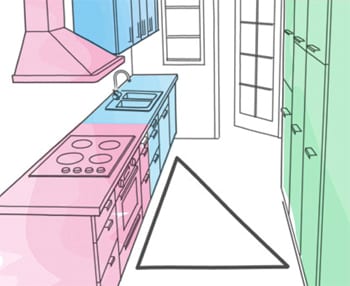The key principle underpinning functional kitchen design for many, many years has been centred around the concept of ‘the working triangle’.
These days, however, most savvy kitchen architects will tell you that applying the working triangle alone is only the beginning. For a truly multi-purpose, functional kitchen, you should involve a variety of other modern elements of design as well.
So what is the kitchen triangle?
The kitchen triangle is formed by creating three connecting lines, each two to three metres in length. The sink, oven or stovetop and fridge sit on each of the triangle vertices.
The triangle concept still serves the purpose of designing a basic and functional kitchen.
However, the ways in which we use the kitchen have changed in recent years, which means thinking has shifted on how we should incorporate the working triangle into modern kitchen design.
Our homes are changing
The reason for this shift is simple, and obvious when we think about the way we live in our homes.
In the past kitchens were substantially smaller than they are now. They were specifically used for the preparation and clean up of meals and constructed primarily to allow one to two people to function in them comfortably.
Kitchens of today are much more than a meal prep room – they’re the hub of the home. They are designed to allow for cooking and eating of course, but also looked at as a work and study space, an entertaining space, and more. The basic requirements of the room ‘kitchen’ have expanded to fit our needs and with that, so has the size of the room.
Therefore for modern design, multiple working triangles would be used to ensue you get the best out of your kitchen!
Zoning – the best way to plan
With this in mind, it seems that the triangle theory has evolved to include the theory of ‘zoning tasks’ in a kitchen.
To use the zoning concept, consider the following points:
- Work out what tasks you do in the kitchen, examples include: food storage, cooking, cleaning up, administrative work, entertaining, eating
- For each task think about what you’ll need in that zone
For the ‘cooking zone’, here is an example of what you may include:
• Stove and oven
• Microwave or combo oven
• Bench space adjacent to the appliances for hot food to be placed
• Storage, with easy access for cooking supplies such as cooking utensils and cookware
For the ‘clean up zone’, keep in mind these elements:
• Sink
• Rubbish and recycling
• Compost
• Dishwasher
• Storage of cleaning products
You may wish to consider these points for the ‘administrative zone’:
• Power outlets
• Phone outlets
• File storage/office storage
• Ability to conceal the area when not in use
• Lighting (as separate to the cooking zone)
• Seating
Overlapping zones
Once you have completed a review for each area, you’ll find you now have multiple mini-triangle work zones forming within your larger kitchen space, with one triangle belonging to each zone.
There is likely to be some need for overlap between and across the zones so it is a good idea to make sure that areas with similar uses are adjacent to one another, for example – the cooking and clean up zones.
The triangle rule has evolved over time, but its core principles integrate nicely into modern kitchen design. Combined with the concept of zoning, you can achieve a stunning and functional kitchen and entertaining area for your home.
